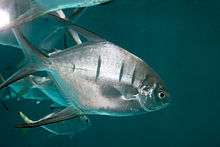Trachinotus goodei
Trachinotus goodei, the palometa, is an ocean-going game fish of the family Carangidae. Other common names include banner pompano, camade fish, cobbler, gafftopsail, great pompano, joefish, longfin pompano, old wife, sand mackerel, streamers jack, wireback.[1] This fish is native to the western Atlantic Ocean from Massachusetts to Bermuda to Argentina. It can be found in the Gulf of Mexico and the Caribbean Sea.[2]
| Trachinotus goodei | |
|---|---|
 | |
| Scientific classification | |
| Kingdom: | Animalia |
| Phylum: | Chordata |
| Class: | Actinopterygii |
| Order: | Carangiformes |
| Family: | Carangidae |
| Genus: | Trachinotus |
| Species: | T. goodei |
| Binomial name | |
| Trachinotus goodei D. S. Jordan & Evermann, 1896 | |
Description
The palometa is best recognized by its elongated dorsal and anal fins with dark anterior lobes.[3] The dorsal fin usually has seven or eight spines and 19-20 soft rays, while the anal fin has two or three spines and 16-18 soft rays.[2]
Its coloration varies from gray to blue-green on the top of its head, and the sides are silver with four narrow, vertical bars. A faint fifth bar shows near the base of the tail. The breast usually has an orange tinge. The tail has no scutes, unlike many members of its family.[4]
The largest known palometa was 50 cm (1 ft 8 in) long.[5] The heaviest was 560 g (1 lb 4 oz).[6]
Biology
The palometa prefers clear, tropical water in sandy shores and bays. It may school above coral reefs.[4]
Little is known about the reproduction of the palometa. It is thought to spawn far offshore during all seasons except winter.[4] Juveniles have shown high growth rates in maricultural experiments.[7]
In the wild, the palometa eats worms, insect pupae, and smaller fish.[2]
.jpg) A palometa seen off the coast of Bonaire
A palometa seen off the coast of Bonaire.jpg) Another palometa, swimming with a sergeant major (Abudefduf saxatilis)
Another palometa, swimming with a sergeant major (Abudefduf saxatilis)
Relationship with humans
Though there have been reports of ciguatera poisoning,[8] the palometa is considered primarily a game fish. Although it is used in aquaculture,[2] few are captured for the aquarium trade. In a review of aquarium fish from Ceará in Brazil, only two palometa were exported between 1995 and 2000, both from Fortaleza.[9] It is rarely used for any other purpose than as a gamefish.
Bathers cooling off in the Parana River in Rosario, 300 kilometres (190 mi) north of Buenos Aires, Argentina on Christmas Day 2013 were attacked by a fish they called 'palometa'. Up to 70 people were bitten, some lost toes and fingers.[10] The actual species claimed to be responsible for the attack was a type of piranha,[11] as 'palometa' is a general common name used for many species of serrasalmids (including several piranhas) in South America.[12][13]
Palometa, Trachinotus goodei, have been farm raised from eggs by Proaquatix,[14] a fish farm in Florida. They are of commercial interest as an ornamental species for large displays and public aquariums.
Etymology
The specific name of this fish honors the American ichthyologist George Brown Goode (1851-1896), who was assistant secretary of the Smithsonian Institution and who was the first to note the presence of this species in the waters of the United States.[15]
See also
References
- Collen, B.; Richman, N.; Beresford, A.; Chenery, A. & Ram, M. (Sampled Red List Index Coordinating Team) (2010). "Trachinotus goodei". IUCN Red List of Threatened Species. 2010: e.T154970A4679678. doi:10.2305/IUCN.UK.2010-4.RLTS.T154970A4679678.en.
- Froese, R. and D. Pauly, Eds. Trachinotus goodei. FishBase. 2011.
- Smith, C.L., 1997. National Audubon Society Field Guide to Tropical Marine Fishes of the Caribbean, the Gulf of Mexico, Florida, the Bahamas, and Bermuda. Alfred A. Knopf, Inc., New York. 720 p.
- Trachinotus goodei. Florida Fish and Wildlife Conservation Commission
- Robins, C. R. and G. C. Ray. 1986. A Field Guide to Atlantic Coast Fishes of North America. Houghton Mifflin Company, Boston. 354 p.
- IGFA, 2001. Database of IGFA Angling Records until 2001. IGFA, Fort Lauderdale, USA.
- Cole, W. M., et al. (1997). Effects of feeding four formulated diets on growth of juvenile palometa, Trachinotus goodei. Journal of Applied Aquaculture 7(2) 51-60.
- Dammann, A.E., 1969. Study of the fisheries potential of the Virgin Islands. Special Report. Contribution No. 1. Virgin Islands Ecological Research Station.
- Monteiro-Neto, C., et al. 2003. Analysis of the marine ornamental fish trade at Ceará State, northeast Brazil. Biodivers. Conserv. 12:1287-1295.
- "Carnivorous fish attack bathers in Argentina". BBC NEWS. 26 December 2013.
- "Argentina: 70 injured in bizarre carnivorous fish attack". komonews.com. Associated Press. 26 Dec 2013. Retrieved 16 January 2014.
- Olimpiadas Nacionales de Contenidos Educativos en Internet (2002). Fauna Ictícola del Río Uruguay. Ministry of Education, Argentina. Retrieved 9 August 2016.
- Machado-Allison, Antonio (2005). Los Peces de los Llanos de Venezuela. Pp. 196-198. Third edition. Central University of Venezuela. ISBN 980-00-2235-X
- "Palometa".
- Christopher Scharpf; Kenneth J. Lazara (10 August 2019). "Order CARANGIFORMES (Jacks)". The ETYFish Project Fish Name Etymology Database. Christopher Scharpf and Kenneth J. Lazara. Retrieved 18 November 2019.
External links
- Photos of Trachinotus goodei on Sealife Collection
